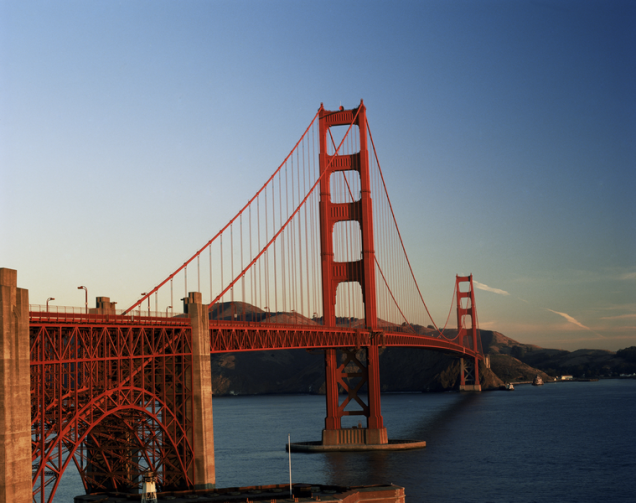Hi there. I don’t think we’ve spoken before, but I’m sure you recognize me. I’m the Golden Gate Bridge. That’s right – the one in San Francisco. I can hear you saying: “A talking bridge? What’s come over you?” But I won’t dignify that with a reply.
I am, after all, an international symbol. Almost a logo. As well as standing for the city itself, I represent the spirit of California, the thrill of 20th century achievement and the freedom of the open road. Quite a heavy burden; but I’m used to those.
I’m here because a columnist from your splendid magazine crossed my path the other day. Actually, he crossed me. On foot. Twice. Most people visit me by car so, you know, respect, dude. Instead of making small talk he popped the big question right away: why am I painted red?
Short answer: I’m not. The official term is International Orange. People will tell you I’m this colour because it allows me to stand out in San Francisco’s notorious fogs. But that’s only half the story. Because I was very nearly painted grey.
It happened like this. When I was built, my parts were covered in a rust-proof primer that just happened to be a reddish colour. As construction continued, my designer Irving Morrow noticed how nicely I blended in with the scenery and formed a beacon for approaching ships.
Morrow may have been a designer, but he was also something of a poet. Almost 20 years earlier he had written of my location: “The narrow strait is caressed by breezes from the blue bay throughout the long golden afternoon, but perhaps it is loveliest at the cool end of the day when, for a few breathless moments, faint afterglows transfigure the grey line of hills.”
See what I mean? As nifty with a description as he was with a charcoal pencil and a sketch book.
With the opening day approaching, a big debate had begun: what colour should I be? The Navy wanted to paint me yellow with black stripes, which would certainly have stood out. But would also have made people seasick. Generally it was felt that grey was the sensible choice. Because, hey, aren’t all monuments grey?
Irving Morrow thought different, as a later California innovator put it. He loved my red colour, and he thought future generations would appreciate it. So he started a campaign. He wrote to newspapers. He wrote to what you might call “influencers”. His campaign even had a slogan: “This bridge will not be grey.” If Twitter had been around back then, he’d probably have added a hashtag. #RedNotGrey
The slogan cropped up recently as the title of a book by Dave Eggers, one of San Francisco’s most popular writers. I love Dave. He also wrote a great book about Silicon Valley called The Circle. If you haven’t read it, I urge you to do so. Or you can wait for the movie with Emma Watson.
Loud and persistent
Anyway, my point is that, way back in 1937, Morrow launched a social media campaign. And it worked. The chorus of voices became louder. And louder. So finally the authorities relented and allowed Morrow to keep the bridge red. Sorry, orange.
Dave Eggers sums up Morrow’s triumph better than I can. “Irving Morrow was loud enough and persistent enough that he could convince all the people and officials in an enormous area like this of the rightness of his idea…It’s really about a moment in history and how certain individuals changed history, and the legacy they leave.”
See what I mean? That’s why he’s a writer, and I’m just a bridge, albeit a totally awesome one. When I was built I was the longest suspension bridge in the world, at 1,300 metres. I took four years to build and cost US$35 million. Dave Eggers didn’t write that – I read it on Wikipedia.
It just proves that Californians have been innovating forever. The first ship-to-shore wireless message was sent from a boat anchored not far from where I am now, in 1853. After that, San Francisco became a hub for communications research, largely funded by the Navy. We had the first radio station in the US. Now the race was on to find the perfect transistor. And in 1957, an inventor called William Shockley discovered that silicon was the best material.
By the 1970s we were the heartland of semiconductor production. In 1971 a journalist named Don Hoefler launched a column called “Silicon Valley in the USA” in the trade newspaper Electronic News. So there you go. Be nice to your columnists, people. They can change history. But maybe not as much as a man with a vision and the power of social media.




